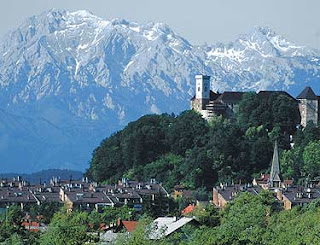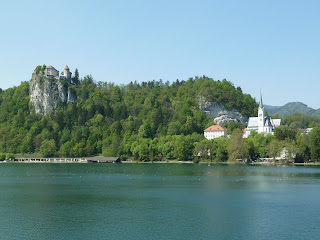 |
| Pirate restaurant, Debrecen |
We left Budapest for the eastern Eastern Central Europe leg of our spring break. Debrecen is the home of our friends Zoltan and Anita, and their two kids Zsofi and Peti, and it's in the very flat Carpathian Basin portion of eastern Hungary, not far at all from Romania. It's the second largest city in Hungary. We met Anita and Zoltan last year when they were in East Lansing with a Fulbright.
 |
| Fountain in the main square |
We found our hotel right away and had only a little bit of time before we needed to find the fountain in the main square, our meeting point. Even though our hotel person didn't speak any English and there were no city maps, we found the fountain fairly easily, and we found our friends who gave us a tour of the downtown area. We went to dinner at a restaurant that actually had a children's menu, and with it's pirate theme, it was a hit with the kids too.
 |
| Debrecen park |
 |
| A much-needed haircut |
The next day we did a little shopping in the morning, had a mid-morning coffee break, and got to see the market, complete with whole pickled cabbage. Jonah was scheduled or a haircut because Anita's salon was right next to our hotel, and she knew an English-speaking haircutter there. Since Jonah is so sensitive about too short haircuts, we thought it might be good to be able to explain that he didn't want too much taken off. The haircut was PERFECT, but Jonah still thought it was too short.
We met Zoltan at Zsofi's elementary school and the kids all got to visit her classroom. Georgie then attended an English language session with Zsofi, which she loved, while the rest of us played at a very well-stocked playground. After Georgie and Zsfoi rejoined us, we all went to the zoo, which was right next to the park. We dodged rain for a little while while walking around, which the kids didn't mind at all, but by the time we left, the sun was out. By car, we followed Zoltan to their house about 10 minutes from Debrecen and enjoyed a fantastic meal, complete with grilled hamburgers for Jonah and Hungarian specialties for the rest of us. The kids got to play with their Wii, they caught about 100 of the chubbiest snails you've ever seen, they got to play with toys that weren't purchased for their portability, and we all got to try Hungarian specialties. Unfortunately for us, Hungary has a zero tolerance law, and you really aren't supposed to drink, even with dinner, if you plan to drive. Because of this law, I limited my intake of homemade plum brandy to one shot, and we made it back to the hotel without needing to take a breathalyzer.
 |
| Hortobagy |
After looking at a map to plan out our last day in Hungary, we decided that Anita's plan was the best. Her plan was to go to Hungary's first national park called Hortobagy (also the name of the village), situated on a steppe (puszta). Hortobagy is a UNESCO world heritage site, about 40 minutes from Debrecen, and the entrance fee would include a horse-drawn carriage ride during which the traditional Hungarian cowboys would show us their skills. You just can't argue with a plan that includes horses, the Hungarian puszta, and cowboys, so at 9AM, after a mad scramble for an ATM to pay our cash-only hotel bill, we left for Hortobagy.
By 10AM, we were on a horse-drawn carriage in the middle of the flattest, emptiest country you've ever seen. Even telephone and electricity lines are buried. In the distance, you could see barns that housed native Hungarian species of black horses (the Nonius) which were the first horses not reserved for the military or the rich, but for the middle-class, and a special breed of sheep with straight, twisted horns. The storks were apparently on their way back from Africa, and we did see storks later that day, but the area is a haven for birds. Many roofs in the Hortobagy area are thatch, which is really fascinating to see up close. It gives you an instant rural and medieval vibe. But they are also practical, since trees don't grow in the alkaline soil, but thatch material does. Some of the thatched rooflines came almost completely down to the ground to minimize the need for timber. They all had lightning rods.
In the middle of the carriage ride, we were given a horse "show" by the Hungarian cowboys. One of them went in a circle around our carriage at top speed, while standing on the backs of two horses. They had the horses perform tricks like sitting (apparently, this is quite a natural position for a horse), and then the horses would play dead while the cowboys simultaneously snapped their whips above their heads. It was as loud as a gunshot, but the horses didn't flinch. The horses needed this skill so they could play dead and wouldn't be agitated by gunshots when the cowboys were dealing with robbers. After the show, we all got to ride the horses, and for the kids, this was certainly the highlight of our entire Hungarian adventure.
The area is a bit like the Old Chrisholm Trail, in that the cattle were driven through the plains (although at a much slower pace than American cattle were driven so the cattle wouldn't lose as much weight). Adam is convinced the cattle moved slower because they stopped for coffee along the way. The cowboys did stop every 10-12 kilometers, a day's drive, at inns/restaurants that were built to host the cowboys. Ultimately, these cattle landed on dinner plates in Italy, Germany, Austria, Turkey, and many other places. The Doge of Venice himself travelled to Debrecen to ensure Venice's supply of beef. We all learned quite a bit about this region thanks to our excellent translator, Zoltan. Before heading home, we had a great lunch at one of these old inns on the cattle route. It was the fourth time I had goulash soup in five days, and I would have it again today if I could!
Many thanks to Zoltan and Anita for making the second leg of our spring break so memorable. And if I ever have to start a kid birthday party planning business in Hungary, I would design Hungarian cowboy birthday parties.























































